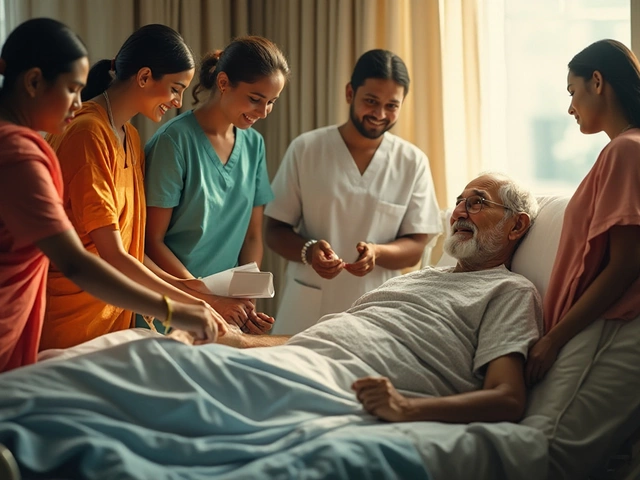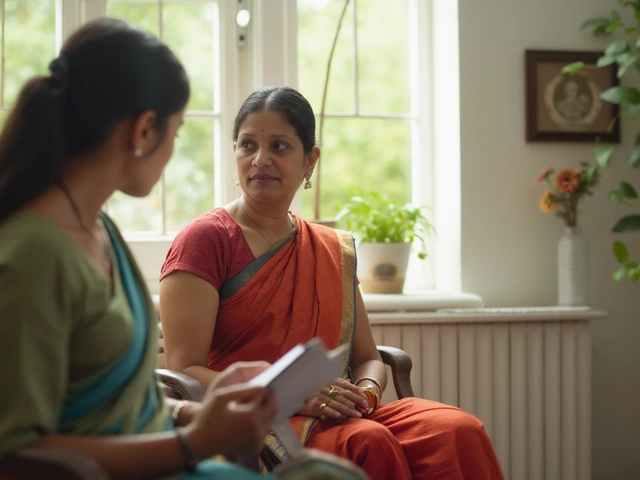So you’re heading home after open heart surgery and wondering what it actually takes to make recovery smoother. You can’t just wing it—small things you set up now will save you a ton of stress later. First off, think about daily comfort: loose clothes that open in the front, a stack of clean towels, a pitch-perfect spot on the couch with plenty of pillows. The easier it is to get up and down, the less you’ll worry about hurting your chest or stitches.
Mobility becomes a whole new game post-surgery. You’ll need a firm chair with armrests, probably a shower chair too, and a handheld shower head if you want to avoid awkward, exhausting moves. Keep everyday stuff like your phone, water, and meds close by—walking around too soon or too much isn’t a medal-worthy activity right now.
Don’t forget about safety. Slippery bathroom floors? Throw down some non-slip mats. Tight walkways packed with furniture? Clear them out. If you’ve got stairs at home, plan ahead—figure out a safe way to get up and down, or set yourself up for a while on one level.
Your home will be your mini-hospital for a bit, but it can feel a lot less clinical if you plan it right. This isn’t just about surviving the days—it’s making each step easier so you can focus on healing instead of headaches.
- Must-Have Supplies and Equipment
- Setting Up Your Home for Safety
- Daily Habits and Helpful Routines
- Getting Real About Support
Must-Have Supplies and Equipment
Getting serious about your open heart surgery recovery at home? You’ll want to stock up on a few things right from the start. These aren’t fancy gadgets; they’re the real stuff people use every day during that tough first month.
- Open heart surgery patients need a firm chair with arms—not a low couch you sink into. Getting up safely is key, and armrests make it so much easier.
- Shower chair or stool: Standing for long periods in hot water is tough after surgery. A handheld shower head is another game changer to help you keep wounds dry and avoid awkward movements.
- Grabber tool: Reaching for stuff off the floor? Skip it. Use a grabber tool to avoid bending and risking your incision.
- Pill organizer: You’ll probably have a mix of new meds for pain, blood thinning, and infection prevention. A weekly organizer cuts mix-ups.
- Digital thermometer and blood pressure monitor: Tracking your numbers—the way your care team asks—matters because spikes or drops early on usually mean something’s up.
- Water bottle and snacks within arm’s reach: Keep your stuff close and avoid those unnecessary treks across the house.
"Home recovery is safest when patients have the right supplies—small things like a sturdy chair or organizer can make a huge difference in avoiding complications." — American Heart Association
If you’re into numbers, look at this snapshot from a 2023 home recovery survey among heart surgery patients:
| Supply | % Reporting It as "Crucial" |
|---|---|
| Firm Chair with Armrests | 78% |
| Shower Chair or Stool | 69% |
| Grabber Tool | 54% |
| Pill Organizer | 82% |
| Blood Pressure Monitor | 88% |
These aren’t just “nice to haves”—they top the list for real folks going through recovery at home. Make things easy on yourself and get these tools in place before you walk in the door. You’ll thank yourself every single day you don’t have to struggle with basics.
Setting Up Your Home for Safety
Your home isn’t just a place to crash after surgery—it’s the front line in your recovery. Safety comes first, and a few easy tweaks can lower your risk of falls, infections, and extra strain.
Let’s start with the basics. Make sure walkways and doorways are free from clutter, loose rugs, and cords. Clear paths limit your chances of tripping, especially if you’re moving a bit slower or using a walker. Next, pay extra attention to the bathroom. It’s the number one spot for accidents because of wet floors and tight spaces. Lay down non-slip mats in and out of the shower, and grab bars are a game changer. They’re cheap, easy to install, and they help you move safely in and out of the tub or off the toilet.
Stairs are another biggie. If you have stairs at home, set up your main living area on one floor if possible. If you have to use stairs, make sure railings are sturdy and keep the steps well lit at all times—no burnt out bulbs. Even simple things like extra night lights in the hallway or near the bathroom make those midnight trips less risky.
Stock up on common items before you even leave the hospital. You don’t want to be stretching or reaching up high for stuff. Place things like your open heart surgery supplies, snacks, and medications within easy arm’s reach, especially in the kitchen or bedside.
- Put a small table next to your favorite chair for remotes, water, and your phone.
- Keep extra blankets nearby to help if you get cold—this also means you don’t need to get up as often.
- Wear supportive, backless shoes or non-slip socks to avoid falls, especially on hardwood or tile.
If you’re using a walker, cane, or anything else to get around, double-check that all floors are clear and flat. No pet toys or mail piles. In fact, getting a friend or family member to double-check your setup is smart—you might miss stuff if you’ve lived with it for years.
Setting up your home for safety is boring but critical. A few changes now will save you from future headaches and keep recovery on track, so you can actually focus on getting better instead of dodging disasters at home.

Daily Habits and Helpful Routines
The right routines can make or break open heart surgery recovery. After surgery, stuff you took for granted gets trickier—so it pays to nail down a schedule that’s simple, safe, and keeps you moving forward. Let’s talk about what actually works at home.
- Stick to Your Meds: Always take your meds at the same time each day. Make a checklist or set phone reminders. Missing doses is way more common (and risky) than you’d think.
- Walk, But Don’t Race: Short walks around the house help prevent clots and boost healing. According to the American Heart Association, most patients can start with three five-minute walks a day in the first couple of weeks. Gradually add time as you feel stronger.
- Nap Smart: Rest is good, but keep naps short and during daylight. Too much sleeping kills your night’s sleep and makes daytime sluggishness worse.
- Eat and Hydrate Right: Balanced meals with plenty of veggies, lean protein, and whole grains really do speed up healing. Skip salty snacks—fluid retention is no joke after surgery. Drink water, but check with your doc on how much, since hearts and kidneys sometimes get picky about your fluid intake now.
- Play It Safe With Wounds: Keep the surgical site clean and dry. Change dressings only as directed. Wash hands before touching your chest or bandages to avoid infections, which hit about 2-5% of patients after open heart procedures.
Tracking your progress is easier than you think. Here's a look at some stats you might find helpful:
| Daily Activity | Recommended Frequency | Why It Matters |
|---|---|---|
| Walking | 2-3 times | Prevents blood clots, rebuilds stamina |
| Vitals Check (BP, temp) | Once daily | Early warning for complications |
| Wound Check | Every day | Catch infections fast |
| Medication | As prescribed | Keeps heart safe and steady |
Consistency is your best friend. The more you make these healthy habits part of your day, the faster you’ll see progress, both physically and mentally. If you’re ever unsure if you’re doing enough—or too much—call your care team. Recovery is not about toughing it out alone; it’s about steady wins and avoiding setbacks.
Getting Real About Support
You can have all the right supplies and gear at home, but recovery isn’t a solo mission. You’ll need real, day-to-day backup—especially in those first weeks after open heart surgery. Trying to tough it out and do everything yourself just adds stress, slows down healing, and risks complications. Most hospitals even recommend having someone stay with you 24/7 for at least the first week.
Friends or family should help with things like prepping meals, running errands, and keeping track of your meds. Bathing, dressing, and walking—even these basics can feel like Olympic sports when you’re still sore and tired. Don’t feel awkward asking for help; it speeds up your recovery and helps you avoid infections or falls.
- Medication tracking: It’s easy to forget doses when you’re tired or in pain. Setting reminders on your phone, or having a buddy check off each dose, can keep things running smoothly.
- Meal prep: Heart-healthy meals matter, but you might not have the energy (or appetite) to cook. Batch-cooked soups, chopped fruits, and pre-packed snacks keep life simple.
- Transportation: Driving isn’t a good idea for weeks after surgery. Rely on friends or family to get you to follow-ups and cardiac rehab sessions.
- Emotional support: Feeling anxious, sad, or just plain frustrated is common. Having someone to talk to, or joining a local or online support group, actually improves outcomes. Real talk: your heart and your mind both need TLC.
Check out some quick data below about how much support can impact your recovery:
| Support Type | Impact on Recovery |
|---|---|
| Family/Friends Involved | Reduces complication rates by 30% |
| Post-surgery Home Visits (Nurse/Therapist) | Boosts medication adherence up to 85% |
| Access to Emotional Support | Lowers depression risk post-surgery by 25% |
If your circle is small or busy, ask for backup from home care nurses, community volunteers, or church groups. There’s zero shame in needing help. The goal is simple: heal up faster, feel better, and rattle less about what could go wrong.

 What Is the Hardest Surgery to Recover From? Heart Transplant Recovery Explained
What Is the Hardest Surgery to Recover From? Heart Transplant Recovery Explained
 The Most Diagnosed Mental Disorder Worldwide: Anxiety Disorders Explained
The Most Diagnosed Mental Disorder Worldwide: Anxiety Disorders Explained
 Unveiling the World's Riskiest Heart Surgeries: Insights and Precautions
Unveiling the World's Riskiest Heart Surgeries: Insights and Precautions
 Unusual Behaviors Post-Heart Surgery: Understanding the Causes
Unusual Behaviors Post-Heart Surgery: Understanding the Causes
 Essential Advice: Navigating Conversations with Your Pain Management Doctor
Essential Advice: Navigating Conversations with Your Pain Management Doctor